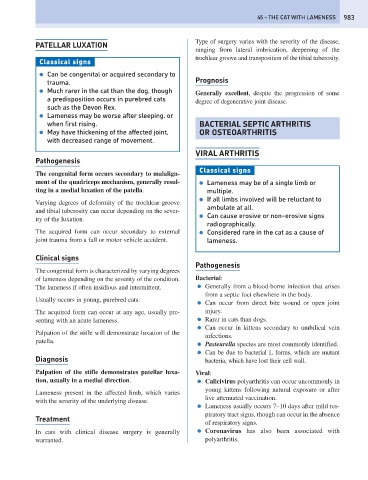Page 991 - Problem-Based Feline Medicine
P. 991
45 – THE CAT WITH LAMENESS 983
Type of surgery varies with the severity of the disease,
PATELLAR LUXATION
ranging from lateral imbrication, deepening of the
trochlear groove and transposition of the tibial tuberosity.
Classical signs
● Can be congenital or acquired secondary to
trauma. Prognosis
● Much rarer in the cat than the dog, though Generally excellent, despite the progression of some
a predisposition occurs in purebred cats degree of degenerative joint disease.
such as the Devon Rex.
● Lameness may be worse after sleeping, or
when first rising. BACTERIAL SEPTIC ARTHRITIS
● May have thickening of the affected joint, OR OSTEOARTHRITIS
with decreased range of movement.
VIRAL ARTHRITIS
Pathogenesis
Classical signs
The congenital form occurs secondary to malalign-
ment of the quadriceps mechanism, generally resul- ● Lameness may be of a single limb or
ting in a medial luxation of the patella. multiple.
● If all limbs involved will be reluctant to
Varying degrees of deformity of the trochlear groove
ambulate at all.
and tibial tuberosity can occur depending on the sever-
● Can cause erosive or non-erosive signs
ity of the luxation.
radiographically.
The acquired form can occur secondary to external ● Considered rare in the cat as a cause of
joint trauma from a fall or motor vehicle accident. lameness.
Clinical signs
Pathogenesis
The congenital form is characterized by varying degrees
of lameness depending on the severity of the condition. Bacterial:
The lameness if often insidious and intermittent. ● Generally from a blood-borne infection that arises
from a septic foci elsewhere in the body.
Usually occurs in young, purebred cats.
● Can occur from direct bite wound or open joint
The acquired form can occur at any age, usually pre- injury.
senting with an acute lameness. ● Rarer in cats than dogs.
● Can occur in kittens secondary to umbilical vein
Palpation of the stifle will demonstrate luxation of the
infections.
patella.
● Pasteurella species are most commonly identified.
● Can be due to bacterial L forms, which are mutant
Diagnosis bacteria, which have lost their cell wall.
Palpation of the stifle demonstrates patellar luxa- Viral:
tion, usually in a medial direction. ● Calicivirus polyarthritis can occur uncommonly in
young kittens following natural exposure or after
Lameness present in the affected limb, which varies
live attenuated vaccination.
with the severity of the underlying disease.
● Lameness usually occurs 7–10 days after mild res-
piratory tract signs, though can occur in the absence
Treatment
of respiratory signs.
In cats with clinical disease surgery is generally ● Coronavirus has also been associated with
warranted. polyarthritis.

